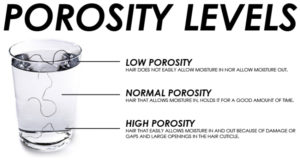Hair Porosity: What It Is and Why It Matters
Last issue on Mind, Body, Live, we talked about the different damages that can be done to hair. Although these are very important to know, another important aspect of healthy hair is knowing your hair porosity. Admittedly, even I hadn’t heard of what this term was or why it was even important. However, after some research on my own hair, I quickly realized that knowing your hair porosity is a must! Knowing it will ultimately give you the best care for your curls.
What is hair porosity?
Hair porosity is your hair’s ability to absorb and retain moisture. Normally, this can be broken down into three categories: low, normal, and high. Depending on the condition of your hair, your cuticle layers could be very open allowing a lot of moisture to enter (high porosity) or it could be very tight, preventing moisture from entering (low porosity).
When your hair has very high porous levels, your hair tends to feel extremely dry because moisture escapes too quickly. You know this is true when you apply a hydrating product into your hair and very quickly you feel little to no difference. WIth high porosity hair, the cuticles of the hair shaft are open, resulting in moisture being unable to stay in after the hair absorbs what is needed.
When your hair has very low porous levels, your hair can sometimes feel very heavy, like products sit on top of it and don’t move. This is because the cuticles are very tight and allow little to no moisture to enter. For this reason, when applying products to this type of hair, they can have almost no effect on it.
How to find out your porosity level?
 Here’s a little test you can do to see if your hair is high in porosity, low in porosity, or just right.
Here’s a little test you can do to see if your hair is high in porosity, low in porosity, or just right.
- Fill up a glass or bowl with water
- Take a couple of strands of your hair and dip it into the water
- Observe: If your hair is floating, then you have low porosity. If your hair is sinking, then you have high porosity.
“What do I do now?”
If you just tested out your hair and determined what category you are under, you may be wondering, “now what?” Here’s where I’ll give you a few tips of what products are good for each hair type.
High Porosity Hair: If your hair sank, then high porosity is what you have. Try adding products that are rich in protein, perhaps an avocado deep conditioner. Aloe and wheat protein are also good to fill in the open gaps of your hair cuticle. Leave-in conditioners and sealers will become your best friend, as well as heavier products such as butters.
Low Porosity Hair: If your hair was floating, then you have low porosity. Since low porosity hair is very tight, this type of hair is prone to build up. Try sticking to protein-free daily conditioners with humectants such as glycerin or honey, something light. You can even use moderate heat as well. Low porosity hair requires moisturizers rich in emollients such as shea butter, jojoba oil, coconut oil and mineral oil, so be sure to stock up on those!
Stay tuned next time on Au Naturale for more tips and tricks!



July 31, 2017
Au Naturale
Hair Porosity: What It Is and Why It Matters
Last issue on Mind, Body, Live, we talked about the different damages that can be done to hair. Although these are very important to know, another important aspect of healthy hair is knowing your hair porosity. Admittedly, even I hadn’t heard of what this term was or why it was even important. However, after some research on my own hair, I quickly realized that knowing your hair porosity is a must! Knowing it will ultimately give you the best care for your curls.
What is hair porosity?
Hair porosity is your hair’s ability to absorb and retain moisture. Normally, this can be broken down into three categories: low, normal, and high. Depending on the condition of your hair, your cuticle layers could be very open allowing a lot of moisture to enter (high porosity) or it could be very tight, preventing moisture from entering (low porosity).
When your hair has very high porous levels, your hair tends to feel extremely dry because moisture escapes too quickly. You know this is true when you apply a hydrating product into your hair and very quickly you feel little to no difference. WIth high porosity hair, the cuticles of the hair shaft are open, resulting in moisture being unable to stay in after the hair absorbs what is needed.
When your hair has very low porous levels, your hair can sometimes feel very heavy, like products sit on top of it and don’t move. This is because the cuticles are very tight and allow little to no moisture to enter. For this reason, when applying products to this type of hair, they can have almost no effect on it.
How to find out your porosity level?
“What do I do now?”
If you just tested out your hair and determined what category you are under, you may be wondering, “now what?” Here’s where I’ll give you a few tips of what products are good for each hair type.
High Porosity Hair: If your hair sank, then high porosity is what you have. Try adding products that are rich in protein, perhaps an avocado deep conditioner. Aloe and wheat protein are also good to fill in the open gaps of your hair cuticle. Leave-in conditioners and sealers will become your best friend, as well as heavier products such as butters.
Low Porosity Hair: If your hair was floating, then you have low porosity. Since low porosity hair is very tight, this type of hair is prone to build up. Try sticking to protein-free daily conditioners with humectants such as glycerin or honey, something light. You can even use moderate heat as well. Low porosity hair requires moisturizers rich in emollients such as shea butter, jojoba oil, coconut oil and mineral oil, so be sure to stock up on those!
Stay tuned next time on Au Naturale for more tips and tricks!